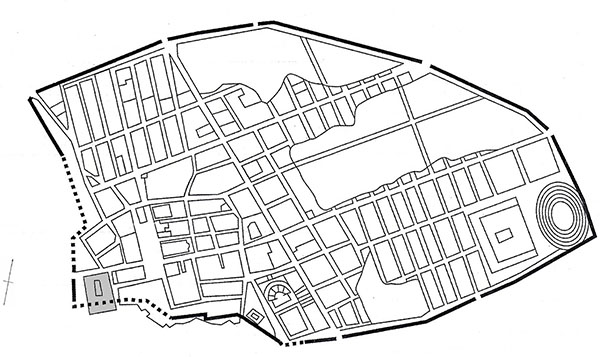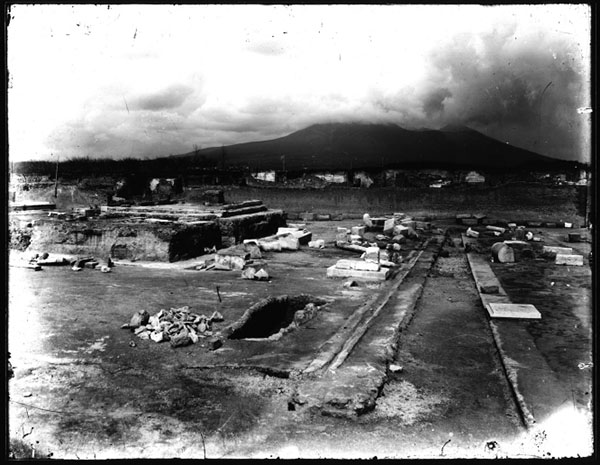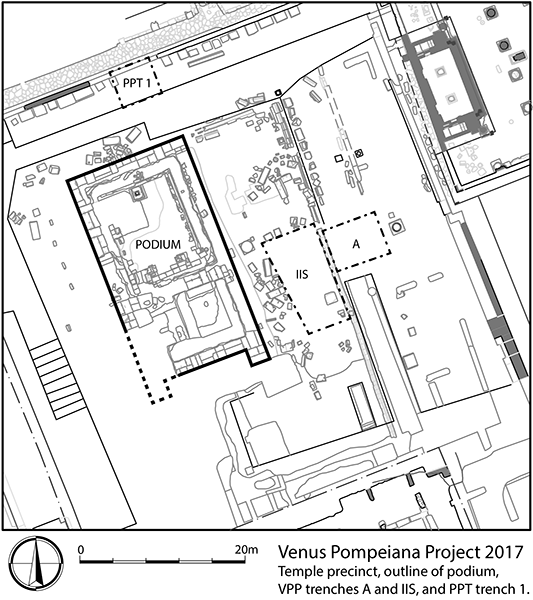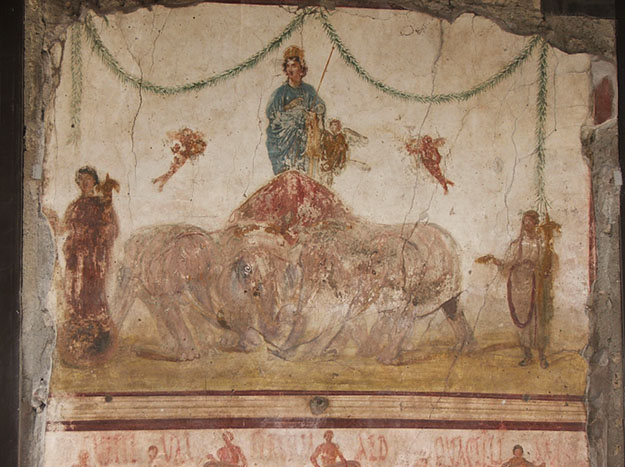The Venus Pompeiana Project (VPP) is a collaboration between the University of Missouri-Columbia and Mount Allison University, under the auspices of the Pompeii Archaeological Park, to resume study of the Sanctuary of Venus at Pompeii.

The Roman goddess Venus was the patron deity of the city of Pompeii, and her temple occupied a prominent location at the southern edge of the site, overlooking the river plain below. The Venus Pompeiana Project (VPP) is a collaboration between the University of Missouri-Columbia and Mount Allison University, under the auspices of the Pompeii Archaeological Park, to resume study of the Sanctuary of Venus at Pompeii. VPP aims to clarify the results of past excavations (most recently) between 2004 and 2007, which were only partially published, and to follow up on questions raised by that work. VPP’s pilot season, in July 2017, was aimed toward identifying the extent and organization of the first sanctuary, and providing greater resolution on its date.

Because of its sudden destruction in 79 CE, Pompeii often leaves visitors with the overall impression of it being a single-phase site frozen in time. On the contrary, the exceptionally well-preserved remains we see today are part of a palimpsest of continuous occupation, stretching back 700 years or more. Although the earlier phases of the site are difficult to reach on an extensive scale due to the later architecture masking the deeper layers, the progress of targeted archaeological research both at key public monuments and across private neighborhoods has revealed a much more complex picture for the settlement history. Recent scholarship has focused particularly on the growth of urban development in the 3rd and 2nd c. BCE, a phase known as the late Samnite period, named after the indigenous Italic people (the Samnites) that occupied the site since the 5th c. BCE. This period has been emphasized as a true “golden age” for the local community. A related, and hotly debated, aspect is the cultural impact of the Roman colonization program after 80 BCE: the views range from radical transformation brought about by the newcomers to a more gradual assimilation process in which the local Samnite ruling class was actively involved.

The Temple of Venus has a long history of investigation. Sogliano was the first to identify the site as the Temple of Venus, in 1898. Intermittent investigations continued over the next century, including the important but unpublished excavations directed by Maiuri before the Second World War. In the 1990s, a project directed by Maureen Carroll identified a series of planting pits within the precinct. Rich archaeological data was collected throughout the 2004–2007 campaigns by Emmanuele Curti, providing evidence that predates the creation of the monumental temple podium and triporticus. This is crucial for assessing and interpreting the degree of cultural change brought about by the Roman conquest of the town. Resuming activities at the Sanctuary of Venus to complement previous work will considerably improve our knowledge of the earliest phases of occupation, and thus of the character of the original cult, allowing us to identify possible changes in religious practice at the site. Few other cult places in Pompeii can provide such detailed contextual information. While remarkable in terms of architectural remains and associated votive deposits, the unsystematic nature of early excavations at most religious sites hinders the possibility of reconstructing their sequence of use. The work of the Venus Pompeiana Project, then, contributes to the current debate on the religious and social history of Pompeii and on the broader implications of Roman imperialism.

Arthur 1986 = P. Arthur, Problems of urbanization of Pompeii. Excavations 1980-1981, in AntJ, 66, 1986, pp. 29-44.
Carroll 2010 = M. Carroll, Exploring the sanctuary of Venus and its sacred grove: politics, cult and identity in Roman Pompeii, in PBSR, 28, 2010, pp. 63-106.
Coletti and Sterpa 2008 = F. Coletti and G. Sterpa, Resti pavimentali in cementizio, mosaico e sectile dall’area del tempio di Venere a Pompei: i dati di scavo, in C. Angelelli and F. Rinaldi (a cura di), Atti del XIII colloquio dell’associazione italiana per lo studio e la conservazione del mosaico (Canosa di Puglia, 21-24 febbraio 2007), Tivoli 2008, pp. 129-143.
Coletti et al. 2010 = F. Coletti, C. Prascina, G. Sterpa, and N. Witte, Venus Pompeiana. Scelte progettuali e procedimenti tecnici per la realizzazione di un edificio sacro tra tarda repubblica e primo impero, in S. Camporeale, H. Dessales, and A. Pizzo (a cura di), Arqueología de la construcción, 2. Los procesos constructivos en el mundo romano. Italia y provincias orientales. Certosa di Pontignano, Siena, 13-15 de noviembre de 2008, Madrid 2010, pp. 189-211.
Curti 2007 = E. Curti, La Venere Fisica trionfante: un nuovo ciclo di iscrizioni dal santuario di Venere a Pompei, in Le perle e il filo. Studi per il 70 anni di Mario Torelli, Venosa 2007, pp. 57-71.
Curti 2008 = E. Curti, Il tempio di Venere Fisica e il porto di Pompei, in P.G. Guzzo and M.P. Guidobaldi (a cura di), Nuove ricerche archeologiche nell’area vesuviana (scavi 2003-2006). Atti del Convegno Internazionale, Roma 1-3 febbraio 2007, Roma 2008, pp. 47-60.
Jacobelli-Pensabene 1995-96 = L. Jacobelli and P. Pensabene, La decorazione architettonica del tempio di Venere a Pompei. Contributo allo studio e alla ricostruzione del santuario, in RSP, 7, 1995-96, pp. 45-76.
Lepone 2004 = A. Lepone, Venus Fisica Pompeiana, in Siris, 5, 2004, pp. 159-169.
Lepone 2017 = A. Lepone, Il tempio di Venere, in E. Lippolis and M. Osanna (a cura di), I Pompeiani e i loro dei. Atti della giornata di studi. Sapienza Università di Roma (15 febbraio 2015), Roma 2017, pp. 89-109.
Martucci 2012 = C.S. Martucci, Defunzionalizzazione di una cisterna: uno scarico votivo nel Tempio di Venere a Pompei, in Per la conoscenza dei Beni culturali, 4. Ricerche del dottorato in metodologie conoscitive per la conservazione e la valorizzazione dei Beni Culturali 2007-2011, Santa Maria Capua Vetere 2012, pp. 55-64.
Mau 1900 = A. Mau, Der Tempel des Venus Pompeiana, in MDAI(R), 15, 1900, pp. 269-308.
Pensabene 1998 = P. Pensabene, Analisi tecnica e formale dei marmi architettonici della casa di Augusto sul Palatino e del tempio di Venere a Pompei, in A. Bettini, B.M. Giannattasio, and L. Quartino (a cura di), Atti della IX Giornata archeologica: archeologia, archeologie, ricerca e metodologie, Genova 1998, pp. 55-124.
Sogliano 1932 = A. Sogliano, Sulla Venus fisica Pompeiana, in AAN, 12, 1932, pp. 359-374.
Varriale 2010 = I. Varriale, I cicli decorativi di età tardo-ellenistica dal tempio di Venere a Pompei, in I. Bragantini (a cura di), Atti del X Congresso Internazionale dell’AIPMA (Association Internationale pour la Peinture Murale Antique), Napoli 2010, pp. 375-386.
Notifications